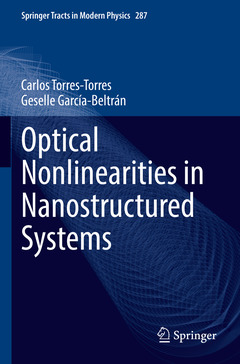Optical Nonlinearities in Nanostructured Systems, 1st ed. 2022 Springer Tracts in Modern Physics Series, Vol. 287
Auteurs : Torres-Torres Carlos, García-Beltrán Geselle

This book provides readers with a detailed overview of second- and third-order nonlinearities in various nanostructures, as well as their potential applications. Interest in the field of nonlinear optics has grown exponentially in recent years and, as a result, there is increasing research on novel nonlinear phenomena and the development of nonlinear photonic devices. Thus, such a book serves as a comprehensive guide for researchers in the field and those seeking to become familiar with it.
Chapter 1. Methods for measuring nonlinear optical properties.- Chapter 2. Theoretical models for describing an enhancement in nanoscale optical nonlinearities for applications design.- Chapter 3. Study on second- and third-order nonlinear optical properties in nanostructured carbon allotropes.- Chapter 4. Study on second- and third-order nonlinear optical properties in metallic nanoparticles.- Chapter 5. Study on second- and third-order nonlinear optical properties in semiconductors nanoparticles and quantum dots.- Chapter 6. Study on second- and third-order nonlinear optical properties in nanostructured systems: nanocrystals and complex geometries.- Chapter 7. Applications, conclusions and perspectives.
Prof. Carlos Torres-Torres’s main research is in nonlinear optics exhibited by nanostructures and thin films. Most of his publications involve the ultrafast optical Kerr effect, laser ablation, and the nonlinear optical absorption in metallic nanoparticles nucleated by ion-implantation, grown by sol-gel methods or prepared by spray pyrolysis processing routes. His research on 2D materials was awarded by the 2013 MRS Spring Congress in San Francisco, California. He is currently a full professor at the Instituto Politécnico Nacional Mexico where he is responsible for the Laboratory of Vectorial Optical Instrumentation. He was awarded best reviewer in 2015 by the Journal of Optics and Laser Technology, Elsevier and also has been awarded outstanding reviewer by various prestigious journals such as the Journal of Physics: Applied Physics, Molecular Liquids, Sensors & Actuators B, Materials Science & Semiconductor Processing, Materials Chemistry and Physics, Applied Surface Science and Optical Materials, Physical Chemistry Chemical Physics, RSC Advances and Physica Scripta. He has published over 100 scientific papers with more than 1000 citations. He is currently a coordinator of a group in the Nanoscience and Micro Nanotechnology Network and head of the group of Instrumentation of Signals in Nanostructures at the Instituto Politécnico Nacional Mexico.
Geselle García-Beltrán is a PhD student at the Instituto Politécnico Nacional Mexico. She received her M.S. in Mechanical Engineering with a thesis related to the nonlinear optics and mechanic phenomena exhibited by nanofluids at the Escuela Superior de Ingeniería Mecánica y Eléctrica Unidad Zacatenco del Instituto Politécnico Nacional Mexico. During her time as a PhD student, she has deepened her knowledge of the nonlinear optical effects of plasmonic carbon/metal nanofluids and nanostructures. Her research has focused on the development of probabilistic logic gates based on third-order nonlinear optical effects<
Presents detailed theoretical models for various nanostructures
Derives important nonlinear coefficients and other measurable properties of nanomaterials
Covers experimental techniques, introductory concepts, and novel applications
Date de parution : 09-2023
Ouvrage de 169 p.
15.5x23.5 cm
Date de parution : 09-2022
Ouvrage de 169 p.
15.5x23.5 cm
Thème d’Optical Nonlinearities in Nanostructured Systems :
Mots-clés :
second-order optical nonlinearities; third-order optical nonlinearities; optical wave mixing; nonlinear coefficients; nonlinear susceptibility tensor; characterization of nanostructures; Fano resonance; Purcell effect; carbon nanotubes; metallic nanostructures; nanocrystals; low-dimensional semiconductors



